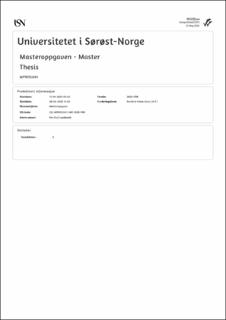| dc.description.abstract | Is there a reduction in the retinal ganglion cell layer and nerve fiber layer thickness in type 2 diabetic patients, a year from baseline recordings, and does this affect their central visual function?
Aim
Diabetic retinopathy is one of the leading causes of blindness worldwide that can be avoided by systemic control of blood glucose levels in diabetic type 2 subjects. Early detection of retinal changes can help practitioners advise and treat patients to reduce the visual impact of diabetes. This study investigated whether there is a change in retinal ganglion layer thickness and nerve fiber layer thickness in Norwegian diabetic type 2 subjects a year from baseline recordings, indicative of neurodegenerative effects of diabetes, prior to vascular retinopathy findings. The secondary objective is to investigate whether there is a subsequent difference in visual function in these subjects, specifically, contrast sensitivity and visual acuity, a year from baseline recordings.
Method
The study is a prospective cross-sectional study in which 45 Norwegian type 2 diabetic subjects (25 male and 20 female) were tested at the University in South-Eastern Norway; over the age of 18. The test subjects underwent an optometric examination testing their best corrected VA, contrast sensitivity using the MARS CS test, and retinal examination with retinal photographs (KOWA) and had SD-OCT scans (volume scan 200x200 and disc scan 200x200) using the Zeiss Cirrus OCT. The exact same tests were then conducted again one year from baseline and the results are compared to establish if there is a reduction in retinal nerve fiber layer (RNFL) thickness (in microns), in quadrants and the global average, and the ganglion cell and inner plexiform layer (GCIPL) thickness, in sectors and the global average, as well as a change in the visual function of these subjects after one year. Descriptive statistics and paired t-tests were used to compare the changes one year from baseline recordings. The level of significance used was 5% (p < 0.05).
Results
The results show that for a type 2 diabetic population (n = 42, mean age = 66 years), the change in GCIPL thickness one year from baseline OD, there is a statistically significant reduction in the mean thickness for sectors 1 and 6 (at a p-level of 0.05). 3 subjects were excluded due to the image quality selection criteria. The average difference in the thicknesses was 0.548 microns thinner one year from baseline, compared to the baseline recordings, (p = 0.036). The change in the GCIPL thickness for OS (n=39) for sector 2, 3 and 5 decreased after one year (p<0.05). The average difference in the thicknesses was 0.359 microns thinner one year from baseline, compared to the baseline recordings, however, this average change was not statistically significant as p>0.05. The RNFL thickness was not significantly different from the one year from baseline results for OD or OS. The results for the visual function show that the VA was not significantly different one year from baseline OD or OS. The CS results are reduced for OU (p<0.05), with a 0.0623 log units reduction OD and 0.064 log units reduction OS.
Conclusion
There was a statistically significant reduction in the GCIPL thickness after one year from baseline for some of the sectors, however this change was not very clinically significant. There was no reduction in the RNFL thickness one year from baseline and no reduction in the VA one year from baseline. The CS results were reduced one year from baseline, although the change was minimal. Therefore, the results are not conclusive due to the short time span of the study and small sample size but do highlight the importance of good baseline recordings in order to measure change over time in diabetic patients. | en_US |
